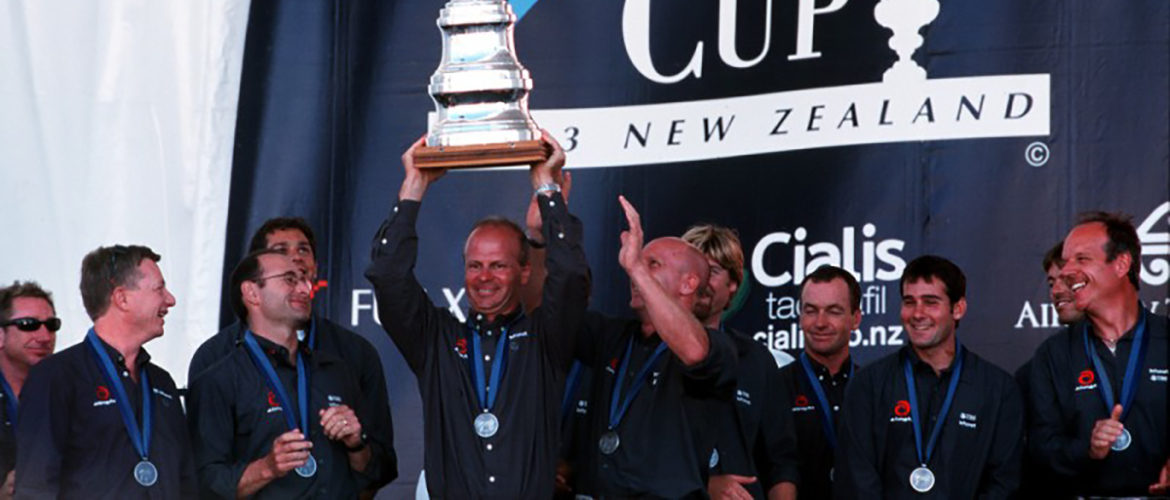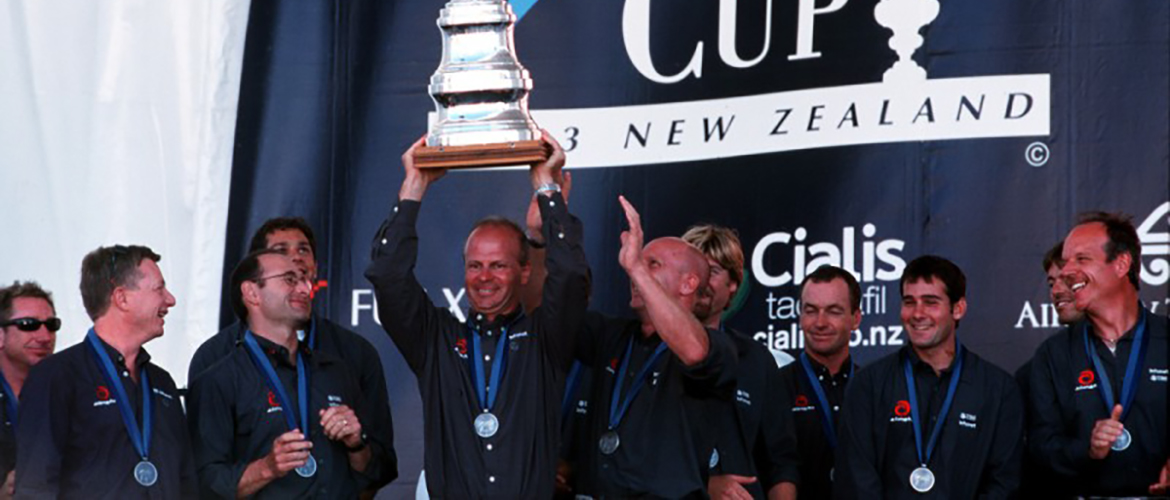America’s Cup Primer, Part III

By Tim Mosso
The 34th America’s Cup will be remembered as one of the most thrilling, technologically innovative, and commercially successful editions in the event’s 162-year history.
The third installment of 300magazine’s America’s Cup showcase relives the event that electrified a global audience of race fans and looks forward to the next edition of yachting’s flagship regatta.
Oracle Team USA’s 9-8 victory over Emirates Team New Zealand involved no fewer than 18 race days, Oracle’s eight consecutive wins in elimination matches, and only the third “sudden death” match ever held in the America’s Cup.
Planning for the 34th America’s Cup began virtually from the moment BMW Oracle Racing defeated two-time consecutive Cup-winning syndicate Alinghi on February 14, 2010. By September of that year, a roadmap for the next edition of the Cup outlined an unprecedented program of preliminary racing events and revolutionary technical regulations for the new yachts.
The scope of the new plan revealed a sport that had embraced fully the modern media’s insatiable appetite for content. A new nine-event preliminary race series and two new yacht design formulas were the highlights.
Organizers, teams, and sponsors of the America’s Cup had struggled for decades to cope with cyclical dips in public interest during what amounted to multi-year off seasons for the regatta-based sport. In order to maintain the visibility of the America’s Cup between competition years, a new annual competition entitled “America’s Cup World Series” was introduced.
While the America’s Cup necessarily pits a single challenger against a lone defender, the America’s Cup World Series included no fewer than eight teams from eight nations in races to be held at six international venues. Moreover, the new race structure allowed both one-on-one matches and general fleet races in order to vary the tests for competitors and improve the spectacle for fans.
The World Series was run on a yearly basis with championship titles awarded to the top team in each cycle of competition. In addition to the elevated exposure for sponsors and increased engagement from fans, the series allowed teams and officials to experiment with new rules and technologies before the main event in San Francisco Bay.
The most significant technological innovation of the World Series was the AC45 catamaran. A “one-design” boat such as the AC45 is a racing craft built to a standardized blueprint provided by the sanctioning body of the series. The intention is to maintain competitive parity between teams while allowing economies of scale and reducing the competitive impact of unequal engineering budgets between teams.
In theory, each team would race with an identical boat, and the outcomes of the races would become a function of crew skill and tactical acumen. In practice, the new formula gave rise to the first major controversy of the new America’s Cup cycle: a cheating scandal.
In the move that would impress A-Rod, Oracle Team USA crewmembers covertly began adding metal weights to the forecastle areas of their AC45 in order to promote higher performance in high-wind conditions. The discovery of this practice led to Oracle losing its individual victories and two titles in the first two America’s Cup World Series. Furthermore, a $250,000 fine was imposed, and Oracle moved to dismiss multiple crewmen who had been implicated.
Of greater significance than the immediate penalties was the sanctioning body’s decision to dock Oracle two points in the upcoming America Cup.
Each win in a Cup race awards one point to the victor. Rules for 2013 dictated that the winner of the Cup would be the first to score nine points, so Oracle’s penalty meant the Defender would require 11 victories in order to retain the cup; the Challenger required only nine to win.
As “weight-gate” unfolded, controversy struck on a second front. A pair of high-speed wrecks brought the safety of the huge AC72 racing “cats” into question.
The mandate of the one-design AC45 was intended to give yacht crews and their engineering teams an opportunity to practice with new hydrofoil catamarans before undertaking development of the large “AC72” yachts for the 34th America’s Cup. In particular, organizers hoped that concerns about safety and stability could be assuaged before the faster and heavier AC72s sailed.
Although multihull boats such as catamarans and trimarans are resistant to capsizing (rolling over), they suffer from a unique susceptibility to “pitchpoling” (tumbling end over end). During Oracle’s 2012 development of its contender, USA-17, the boat pitched forward and rolled while turning away from the wind in San Francisco Bay. Damage to the $10 million boat was extensive, but no injuries resulted from the incident.
By comparison, the Kungliga Svenska Segelsällskapet-sponsored yacht of the Artimis Racing syndicate suffered a tragedy the next year on the eve of the Eighth Louis Vuitton Cup runoff races. While operating in strong San Francisco winds similar to those experienced by Oracle in 2012, Artimis’s eponymous yacht pitchpoled on May 9.
Olympic gold medal-winning sailor Andrew Simpson of Great Britain was killed in the incident.
The size of the AC72s – over 90 feet long and over 130 feet tall – combined with their 50mph+ speed potential to create life-threatening conditions for sailors. Revisions to race protocol were written in the interests of protecting crews. Given the yachts’ ability to sail at up to twice the speed of the wind itself, measures were taken to avoid wrecks at automotive velocities.
A 23mph wind cap was imposed to curtail racing in conditions that could produce lethal speeds and instability. Sailors began to carry body armor and tactical knives to survive high-speed impact and entangled submergence in the event of a pitchpole. Course conduct rules were re-written to eliminate all potential for the chilling worst-case scenario: a 100mph head-on sailboat collision.
The subsequent Louis Vuitton Cup proceeded without incident. The syndicate of Emirates Team New Zealand emerged victorious from a series of round robin and match races. Sponsored by the Royal New Zealand Yacht Squadron, Emirates Team New Zealand’s AC72 Aotearoa proved to be the class of the field, and the vessel dispatched both Luna Rossa of the Circolo della Vela Sicilia and Artemis, the original Challenger of Record for the 34th America’s Cup.
The September 2013 America’s Cup was a marquee event. Sailing superpowers United States and New Zealand met in a showdown that drew a global audience. Blanket coverage was assured by network TV, cable TV, radio, and internet media. New technology was deployed to make the ancient regatta rituals accessible to contemporary audiences, and NBC Sports’s football-style virtual graphics won an Emmy Award for this innovation.
In a powerful testament to the rise of Oceanian mariners in modern regatta, the race pitted Australian skipper Jimmy Spithill on USA-17 against Kiwi Dean Barker’s Aotearoa.
Barker’s distinctive style and profile are well known in the luxury watch community. In addition to his maritime exploits, Barker is best known to readers of Omega watch reviews as a credentialed brand ambassador of the Swiss marque. His success on the water inspired the Seamaster NZL-32 chronograph of 2007, and he maintains active association with the brand.
Oracle CEO Larry Ellison, who had spent an estimated $500 million on the Oracle racing project since 2000, watched his $100 million 2013 contender put to sea on September 7 with a punitive 0-2 deficit before the first race. The deck was stacked, but Oracle’s darkest moments lay ahead.
Energized by victory in the summer’s Louis Vuitton Cup qualifier, Barker captained his crew to a 1-8 points advantage by September 18. The crew of USA-17 found itself faced with seven consecutive elimination matches before a hypothetical winner-take-all eliminator could be forced.
Incredibly, Oracle did win seven consecutive matches over a week of hammer-and-tongs clashes with Aotearoa. The effort was exhausting and nerve-racking for both crews. Aotearoa’s crew was bombarded with media catcalls and mounting fear of a choke unprecedented in Cup history; for Oracle, every day was do-or-die, and the match of September 22 saw the boat escape elimination by a scant 23 seconds.
On September 25, after the longest regatta series in America’s Cup history, USA-17 crossed the finish line 44 seconds ahead of Aotearoa to complete its unlikely defense of the “Auld Mug.” The day’s race represented only the third “sudden death” match in cup history after the 1920 and 1983 events.
Oracle’s last-gasp comeback shocked the world of sports to a degree that drew global attention and hyperbolic commentary from mainstream non-sporting media outlets.
After rocking San Francisco like the San Andreas Fault, organizers of the America’s Cup moved to keep their sport in the headlines. Less than a week after USA-17 sailed into history, Australia’s Hamilton Island Yacht Club issued a new challenge to Team Oracle USA. Financed by billionaire vintner and resort mogul Bob Oatley, the new syndicate has targeted the 35th America’s Cup as the Challenger of Record.
Other competitors of note include the British, once the most dogged and enterprising of America’s Cup Challengers. Oracle Team USA lead tactician Ben Ainslie is organizing a challenger that intends to enter the Ninth Louis Vuitton Cup in hopes of displacing the Challenger of Record. Should he succeed, he will face the double challenge of beating his old employer and completing Britain’s 165-year quest to recover the America’s Cup.
Crews for the yachts of the next Cup are years from being finalized, but the world of professional sailors is sufficiently small that many of the 2013 protagonists are likely to return. Victorious skipper Spithill is a virtual lock to reprise with Oracle, and, as those old archived Omega watch reviews remind readers, the humiliated Captain Barker’s aging laurels still boast sufficient verdure to justify a shot at redemption.
Challengers are likely to multiply as the global economic outlook improves, and the media success of the last Cup placed the sport on the radar of new potential sponsors.
Much is yet to be revealed, but early reports have supplied key details about the 35th Cup. The next America’s Cup will be held in 2017. San Francisco is believed to be the leading candidate venue due to the certainty of race-grade winds and the success of the previous regatta.
The recent Cup’s enormous AC72 catamarans sail into the history books to clear room for a new yacht formula. Like the J-class yachts of the 1930s, the AC72s represented an all-time mark for the America’s Cup. While the J-class proved prohibitively expensive and discouraged post WWII challenges, the AC72’s speed, size, and complexity unnerved crews and officials.
Current plans call for a 60-65 foot racing yacht to become the boat of choice for the next regatta series. The intention of officials is to reduce crew sizes from the AC72’s 11 and reduce the cost of construction by mandating certain standardized components for all contending sailboats.
However, the memorable images of multihull hydrofoils “flying” across San Francisco Bay have lead to the retention of a foiling catamaran layout for the next Cup yachts. Although smaller, the new boats will retain most of the speed and visual impact of the AC72 in order to reprise the spectacle of 2013’s fastest-ever America’s Cup races.
New competition rules and yacht design protocol are due next month, and new America’s Cup World Series warm-up races could be held as early as this year. Some teams aren’t waiting for details and have chosen to start racing as early as possible and wherever possible.
300magazine will be following the action as events build toward the next America’s Cup regatta.
Photo credit: ChameleonsEye / Shutterstock.com

